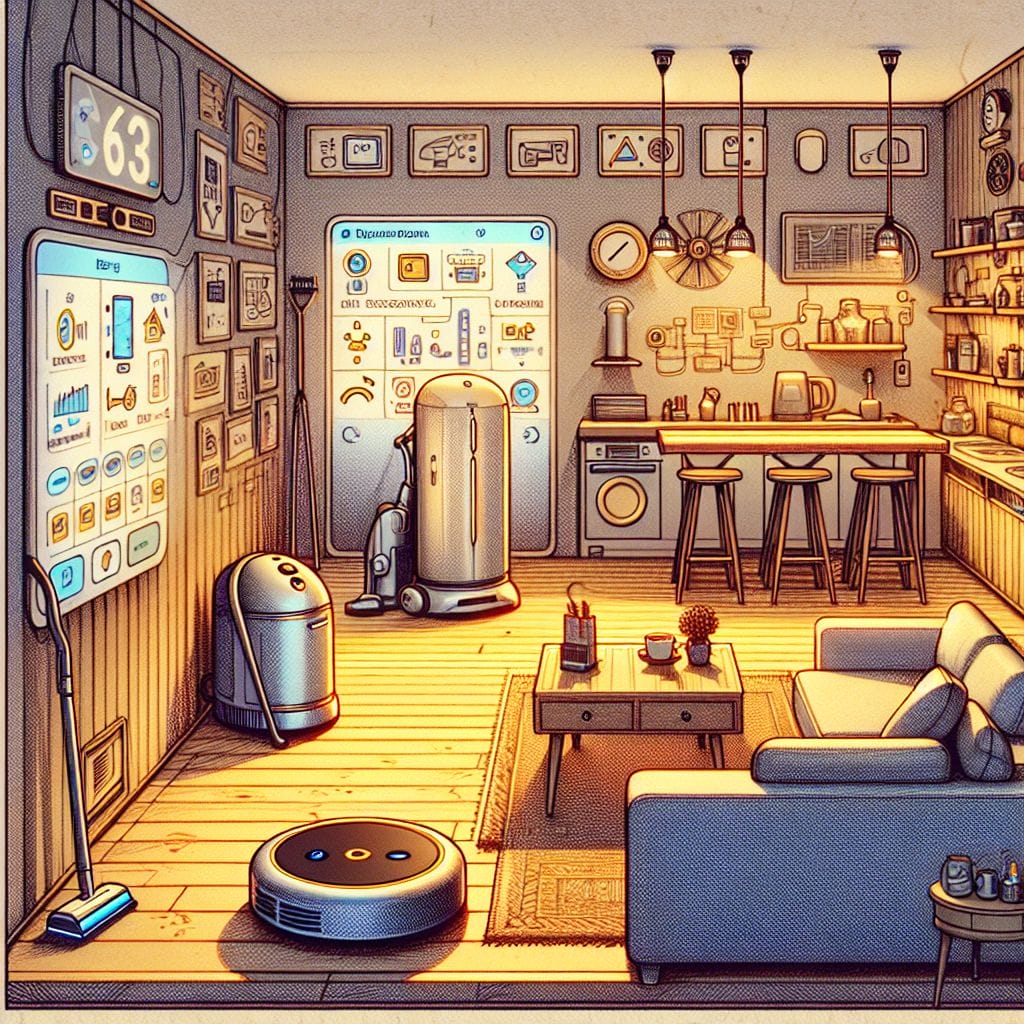
Understanding Home Assistant and Hubitat
In today’s world, smart home technology has become increasingly popular, allowing homeowners to control various aspects of their homes with just a few taps on their smartphones. Two popular smart home platforms that offer a wide range of features and capabilities are Home Assistant and Hubitat. Both platforms allow users to automate their homes, control devices remotely, and enhance their overall living experience. However, choosing the right smart home platform is crucial, as it can significantly impact the functionality and compatibility of your devices. In this article, we will compare Home Assistant and Hubitat regarding user interface, compatibility, automation, security, customization, price, support, and integration to help you decide which platform best suits your needs.
User Interface: Comparing the Ease of Use
The user interface is essential to any smart home platform, as it determines how easily users can navigate and control their devices. Home Assistant offers a user-friendly interface that is intuitive and easy to navigate. The platform provides a dashboard that allows users to control and monitor their devices, create automation rules, and view real-time data. The highly customizable interface allows users to arrange and organize their devices and controls according to their preferences. The integrated Lovelace dashboard is also widely regarded as one of the best available.
On the other hand, Hubitat also offers a user-friendly interface that is designed to be simple and intuitive. The platform provides a dashboard that allows users to control and monitor their devices, create automation rules, and view real-time data. The customizable interface allows users to arrange and organize their devices and controls according to their preferences. It’s important to note that the limited capabilities of the Hubitat Dashboard are a common complaint among users.
Home Assistant and Hubitat offer user-friendly interfaces that are easy to navigate and control. However, Home Assistant may have a slight edge regarding customization options, as it allows users to personalize their interface to a greater extent. Hubitat has an advantage when it comes to simplicity and ease of use.
Compatibility: Which Devices Work Best with Each Platform?
Compatibility is crucial when choosing a smart home platform, as it determines which devices can be integrated and controlled. Home Assistant is known for its extensive device compatibility, supporting a wide range of devices from various manufacturers. The platform supports popular smart home protocols such as Zigbee, Z-Wave, Wi-Fi, and Bluetooth, allowing users to connect and control devices from different brands seamlessly.
Similarly, Hubitat offers a wide range of device compatibility, supporting popular smart home protocols such as Zigbee, Z-Wave, Wi-Fi, and Bluetooth. The platform is compatible with various devices from different manufacturers, allowing users to integrate and control their devices effortlessly.
Home Assistant and Hubitat offer a wide range of options regarding device compatibility. However, Home Assistant has the advantage of supporting a more significant number of devices and manufacturers.
Automation: Which Platform Offers More Advanced Features?
Automation is a crucial feature of any smart home platform, as it allows users to create custom rules and routines to automate their devices and enhance their living experience. Home Assistant offers advanced automation features, allowing users to develop complex rules based on various triggers and conditions. The platform supports various automation options, including time-based, sensor-based, and event-based triggers. Users can create automation rules to control lights, thermostats, locks, and other devices based on specific conditions or events. Users may find the built-in automation engine a bit limiting, making Node-Red a popular add-on for more complex rules.
Similarly, Hubitat offers advanced automation features, allowing users to create custom rules and routines to automate their devices. The platform supports various automation options, including time-based, sensor-based, and event-based triggers. Users can create automation rules to control lights, thermostats, locks, and other devices based on specific conditions or events. Hubitat’s Rule Machine offers a lot of control and allows complex rules to be created and maintained relatively easily. In addition, the popular webCoRE is available to let you make more advanced rules and allow more control over devices.
Home Assistant and Hubitat offer advanced automation features, allowing users to create custom rules and routines. However, Home Assistant may have a slight advantage in providing more advanced and complex automation options, while new users may find Hubitat easier to start. It’s also important to note that both can be intimidating and confusing to new users who have never done any home automation in the past compared to the simplicity offered by Samsung SmartThings, Google Assistant or Amazon Alexa.
Security: Which Platform Offers Better Protection for Your Home?
Security is critical to any smart home platform, as it ensures the protection and privacy of your home and personal data. Home Assistant offers robust security features, including end-to-end encryption, two-factor authentication, and secure remote access. The platform also allows users to create custom security rules and routines to enhance the security of their devices and prevent unauthorized access.
Hubitat also offers some security features but falls short of Home Assistant. Hubitat doesn’t recommend you expose your hub directly to the internet for remote access, and they steer you towards their Remote Access subscription.
Both Home Assistant and Hubitat offer security features that ensure the protection and privacy of your home. However, Home Assistant has an advantage in providing more advanced security options and customization capabilities.
Customization: Which Platform Offers More Flexibility?
Customization is essential to any smart home platform, as it allows users to personalize their experience and tailor the platform to their specific needs. Home Assistant offers extensive customization options, allowing users to personalize their interface, create custom automation rules, and integrate third-party services and devices. The platform supports a wide range of customization options, including custom themes, custom icons, and custom scripts.
Similarly, Hubitat also offers customization options, allowing users to create custom automation rules, and integrate third-party services and devices.
Home Assistant and Hubitat offer customization options, allowing users to personalize their experience. However, Home Assistant has the advantage of providing more advanced customization capabilities and flexibility.
Price: Comparing the Cost of Home Assistant and Hubitat
Price is essential when choosing a smart home platform, as it determines the overall cost of setting up and maintaining your smart home. Home Assistant is an open-source platform available for free, allowing users to download and install the software on their hardware. However, an annual subscription is required to integrate with Amazon Alexa or Google Assistant. This subscription also offers secure access to your Home Assistant when you aren’t home. Many users comment that the subscription price is steep, considering what it offers. Additional hardware is required to support Zigbee and Z-wave devices, increasing the cost.
On the other hand, Hubitat is a commercial platform that requires users to purchase the Hubitat Elevation hub, which serves as the central control unit for the smart home. The hub is available at a one-time cost, and users do not need to pay additional fees for using the platform. Remote access and remote backup and protection plans are available.
Regarding pricing, Home Assistant has the advantage of being available for free, while Hubitat requires users to purchase the hub. However, the overall cost of setting up and maintaining a smart home may vary depending on your specific devices and accessories.
Support: Which Platform Offers Better Technical Assistance?
Technical support is an important aspect of any smart home platform, as it ensures that users can get help and assistance when needed. Home Assistant offers a variety of technical support options, including a community forum, documentation, and online tutorials. The platform has a large and active community of users willing to help and provide guidance.
Similarly, Hubitat offers technical support options, including a community forum, documentation, and online tutorials. The platform has a dedicated support team to assist users with any issues or questions via the community forums.
Home Assistant and Hubitat offer technical support options that ensure users can get help and assistance. However, Home Assistant may have a slight advantage in having a larger and more active community of users who can provide guidance and support.
Integration: Which Platform Works Better with Other Smart Home Systems?
Integration is crucial to any smart home platform, as it determines how well the platform can work with other smart home systems and devices. Home Assistant offers extensive integration capabilities, allowing users to connect and control devices from different manufacturers seamlessly. The platform supports popular smart home protocols such as Zigbee, Z-Wave, Wi-Fi, and Bluetooth, allowing users to integrate devices from other brands effortlessly.
Similarly, Hubitat offers integration capabilities, allowing users to connect and control devices from different manufacturers. The platform supports popular smart home protocols such as Zigbee, Z-Wave, Wi-Fi, and Bluetooth, allowing users to integrate devices from other brands seamlessly.
Home Assistant and Hubitat offer extensive integration capabilities that allow users to connect and control devices from different manufacturers. However, Home Assistant has the advantage of supporting a more significant number of devices and manufacturers.
Conclusion: Which Platform is Right for You?
In conclusion, Home Assistant and Hubitat offer many features and capabilities to enhance your smart home experience. When choosing between the two platforms, it is essential to consider factors such as user interface, compatibility, automation, security, customization, price, support, and integration.
If you are looking for a platform with extensive customization options and advanced automation features, Home Assistant may be the right choice. The platform offers a highly customizable interface, supports various devices, and provides advanced automation capabilities.
On the other hand, if you are looking for a user-friendly platform, Hubitat may be the right choice. The platform offers a customizable interface, supports various devices, and provides a simpler user experience.
Ultimately, the choice between Home Assistant and Hubitat depends on your needs and preferences. It is essential to carefully evaluate the features and capabilities of each platform and consider factors such as user interface, compatibility, automation, security, customization, price, support, and integration before making a decision. I happily ran Hubitat for many years but recently switched to Home Assistant to get more of my smart home devices and services working together. Both are great platforms and have their strengths and weaknesses.
